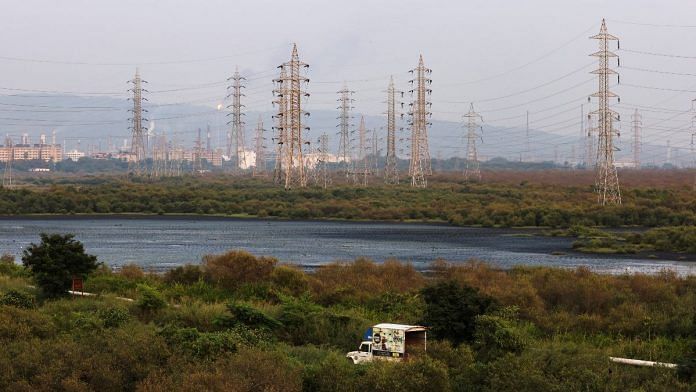New Delhi: The interim Budget for 2024-2025 announced Thursday saw focus on green energy and electric vehicles, which continued the government’s journey towards achieving net zero emissions by 2070.
Finance Minister Nirmala Sitharaman envisaged a ‘Viksit Bharat’ by 2047, and emphasised on developing clean energy in the environment and sustainability sector. From viability gap funding for offshore wind energy to rooftop solar power installations in one crore households.
The Budget also mentioned mandatory blending of compressed biogas with compressed natural gas for the transport sector, and piped natural gas for domestic use.
For the electric vehicle sector, the government announced increased support for manufacturing and charging infrastructure, as well as a push for the adoption of e-buses in public transport.
Solar & wind energy
Monetarily, the solar power (grid) scheme saw a major bump as its budget allocation increased to Rs 10,000 crore in 2024-2025, from Rs 4,970 crore in 2023-24. The rooftop solarisation programme, called “Pradhan Mantri Suryoday Yojana (PMSY)”, was announced by Prime Minister Narendra Modi on 22 January. It aims to give one crore households access to 300 units of free electricity every month.
According to an analysis by the Council on Energy, Environment and Water (CEEW), this programme will add another 20 to 25 gigawatts (GW) to India’s rooftop solar capacity, which currently stands at 10.2 GW.
“Households with rooftop solar power also stand to save Rs 15,000 to Rs 18,000 annually from free electricity and selling the surplus electricity to discoms,” Sitharaman said.
Wind energy saw a decrease in its budgetary allocation from Rs 1,214 crore in 2023-24 to Rs 930 crore in 2024-25. However, the Budget announced viability gap funding to harness offshore wind power for an initial 1GW of wind energy.
Viability gap funding is a form of funding that encourages public-private partnerships in areas that are important economically but not viable financially. As the name suggests, the government fills the gap in funding to make the project viable.
In the 2023 Budget, the government had announced a viability gap funding scheme for developing battery energy storage systems, with a capacity of 4,000 megawatts (MWh).
“The viability gap funding for offshore wind is a huge positive. This will change the game for wind energy and help in utilising India’s long coastline,” said Dhruba Purkayastha, the India Director of Climate Policy Initiative, in a press statement.
Bio energy and EVs
While not as much as the wind and solar energy sectors, bio-energy still saw a boost in its monetary allocation in the interim budget. From Rs 75 crore in 2023-24, the bio-energy programme has an increased budget of Rs 300 crore in 2024-25.
This increase reflects the government’s announcement of mandatory phased blending of CNG and PNG with compressed biogas. The FM also mentioned in her speech that the government would assist in procuring biomass aggregation machinery.
However, Vibhuti Garg, the South Asia Director of the Institute for Energy, Economics and Financial Analysis (IEEFA), called for more clarity on this. “Biogas can play a critical role but whether it is ethanol from sugarcane or maize or excess feedstocks needs distinction,” she told the media.
The interim Budget also indicated a positive push for electric vehicles in the country. “The electric vehicle ecosystem will be expanded and strengthened by supporting manufacturing and charging infrastructure,” said Sitharaman in her Budget speech. “We will support greater adoption of e-buses for public transport through payment security mechanisms,” she added.
Although the finance minister’s speech mentioned a boost for electric vehicles manufacturing and charging, the Scheme for Faster Adoption and Manufacturing of (Hybrid and) Electric Vehicles in India (FAME – India) saw a budget of Rs 2,671 crore this year, down from Rs 5,172 crore last year.
“The Payment Security Mechanism (PSM) mentioned by the finance minister will attract private investments in electric buses without the need for government budgetary support,” said Saurabh Kumar, Vice President – India, Global Energy Alliance for People and Planet (GEAPP). “This is much more efficient than budgetary allocations, as it would leverage more than Rs 75,000 crore to electrify 50,000 buses in India,” he added.
Another major announcement by the FM was that the government would set up coal gasification and liquefaction facilities in India for 100 mega tonnes by 2030.
This, according to her, would reduce India’s reliance on imports of methanol and ammonia. Gasification of coal is considered to be a more sustainable option compared to burning coal. Through gasification, coal is converted to synthetic natural gas, energy fuel such as methanol, and ammonia for fertilisers. This project, however, was announced by the ministry of coal in 2020.
“The interim budget has just scratched the surface for net zero by mentioning offshore wind, biofuels, and coal gasification but a lot more needs to be done in the space for deploying large-scale clean energy solutions for transport and industries in particular,” said IEEFA’s Vibhuti Garg in a statement.
(Edited by Tikli Basu)
Also read: ‘Walked the path of fiscal prudence’ — what economists say about interim budget 2024’s fiscal maths



